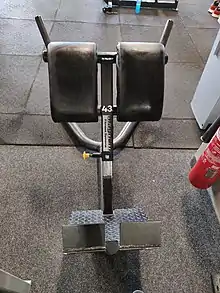Hyperextension (exercise)
A back extension is an exercise that works the lower back as well as the mid and upper back, specifically the Erector spinae. Each of us have two Erector spinae muscles, one of either side of the spine that run along the entire length of the spine. Erector spinae muscles are actually formed of three smaller muscles – spinalis, longissimus, and iliocostalis.[1]
_animation.gif)
Hyperextension as a misnormer
The name hyperextension is commonly used for back extension exercises that are done using a hyperextension bench in a fitness gym. However the name 'hyperextensions' is a misnomer, because hyperextension means a movement where extension is performed at any joint beyond its normal range of motion. Instead, what one is trying to achieve in the back extension exercise is only to extend the spine within its normal range and not beyond its normal range of motion. When you extend the back from the flexed position, at the end range, your head and neck stays in neutral position.[2]
In fact, back extension beyond the normal range of motion has been found to be detrimental for the exerciser. Hyperextensions during dead lift have been found to lead to lumbar disc pathologies and muscular spasms.[3]
Equipment used

Back extensions can be performed with or without various equipment.
- Without any equipment
- It may be performed on the ground by lying prone with arms overhead and lifting the arms, upper torso, and legs as far as possible. Here you use gravity as resistance to strengthen the back extensor muscles.[4]
 Diagonal back extensions performed on the floor
Diagonal back extensions performed on the floor
- Using a Roman chair
- A Roman chair helps to stabilize the legs up until the hip joints while performing low back extension. To perform the exercise, the torso from above the hip joints is flexed forwards and down towards the floor. And to complete the exercise, the person contracts his back muscles (Erector spinae) and raises his torso up till his whole body is in a straight line from his head to heels. Exercises could be more challenging by adding the person hugging weights to his chest. Lighter weights may be used to begin with to prevent straining the back muscles with over-exertion. Hold the weight lower in position, if you are a beginner and then gradually bring it higher, to feel more resistance.[2]
- Using a back extension bench (hyperextension bench)
- There are two varieties of back extension benches depending upon the angle that they support your lower body, the 45 degrees and 90 degrees back extension bench. The 90 degrees back extension bench is also called Roman chair that was discussed above. Here the body lies horizontally and the person can experience full back range of motion. This stands in comparison to the 45 degree back extension bench, where the person would be almost standing and it allows extension only up to partial range of motion. In both the versions of the back extension bench, the person is requested to fold their arms in front of themselves or place their hands on the back of the head with the elbows pointing to the sides, while performing the exercise.[2]
 A 45 degree back extension bench (note the different type of leg support from the Roman chair)
A 45 degree back extension bench (note the different type of leg support from the Roman chair) Woman performing back extensions in a near 90 degree bench
Woman performing back extensions in a near 90 degree bench
- Using a reverse back extension machine (reverse hyperextension machine)
- This machine has been used to strengthen not only the erector spinae muscle, but also gluteus maximus and part of hamstring muscles (biceps femoris). When back extension is attempted with this machine, the range of motion at hip is found to be relatively more, while the accompanying stresses at hip and back have been found not to relatively less.[5]
See also
References
- Kendall, Florence P. (2014). Muscles: Testing and Function, with Posture and Pain. Wolters Kluwer Health. ISBN 978-0781747806.
- Fetters, K. Aleisha (2019-01-29). "Build a Bigger Back With These 8 Exercises". Men's Health. Retrieved 2021-06-22.
- DailyBurn, Amy Schlinger for Life by (2015-06-05). "10 dangerous exercises that lead to injuries". CNN. Retrieved 2021-08-21.
- Adam, Lisa (2017-09-14). "6 Exercises That Don't Require Equipment". Wize Prep. Retrieved 2019-04-17.
- Lawrence, Michael A.; Chin, Andrew; Swanson, Brian T. (2019). "Biomechanical Comparison of the Reverse Hyperextension Machine and the Hyperextension Exercise". Journal of Strength and Conditioning Research. 33 (8): 2053–2056. doi:10.1519/JSC.0000000000003146. ISSN 1064-8011. PMID 30946266.